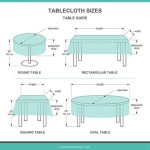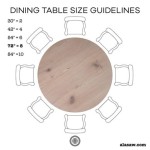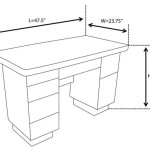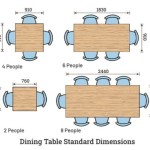Round Table Dimensions: A Comprehensive Guide
Round tables, renowned for their ability to foster conversation and promote equality among participants, are a popular choice for dining spaces, conference rooms, and collaborative workspaces. Determining the appropriate dimensions for a round table is crucial to ensuring comfort, functionality, and aesthetic appeal. This article will explore various aspects of round table dimensions, providing a comprehensive guide for selecting the ideal size based on different needs and contexts. Understanding the relationship between table diameter, seating capacity, and available space is essential for making an informed decision.
Factors Influencing Round Table Dimensions
Several factors come into play when determining the optimal dimensions for a round table. These considerations extend beyond simply fitting the table into a designated space. They involve understanding the intended use of the table, the number of people intended to be seated, and the overall comfort level desired. Paying attention to these factors will ensure the table serves its purpose effectively and enhances the overall experience of those using it.
One of the primary factors is the
intended use of the table.
A round table intended for formal dining will have different dimension requirements than one used for casual gatherings or a small conference. Formal dining typically requires more space per person to accommodate multiple courses, larger plates, and utensils. A conference table, on the other hand, may prioritize legroom and space for note-taking or laptop use.The
number of people to be seated
is another critical consideration. Round tables offer flexibility in seating arrangements, but exceeding the recommended capacity can lead to overcrowding and discomfort. Accurate estimation of the average number of users is crucial for selecting a table with an appropriate diameter. This estimation should consider typical usage scenarios and potential for occasional larger gatherings.Finally,
available space
plays a significant role in determining the maximum acceptable dimensions of the round table. Measuring the room or area where the table will be placed is essential. Leave sufficient space around the table for comfortable movement and access to seating. This includes considering walkways, doorways, and other furniture within the space. A cramped environment can hinder the functionality and diminish the overall enjoyment of the table.Standard Round Table Sizes and Seating Capacities
Round tables are available in a variety of standard sizes, each designed to accommodate a specific number of people comfortably. Understanding these standard dimensions and their corresponding seating capacities is essential for making an informed decision. These dimensions are generally based on industry standards and ergonomic considerations to ensure adequate space per person for dining, working, or collaborating.
A round table with a diameter of
36 inches (3 feet)
is typically suitable for seating2-3 people.
This size is often used in small apartments, breakfast nooks, or as an accent piece. Due to its compact size, it may not be ideal for formal dining or activities requiring significant surface space.A
48-inch (4 feet)
round table can comfortably seat4 people.
This is a common size for smaller dining spaces or kitchens. It provides sufficient space for a family of four to dine comfortably, while still maintaining a relatively small footprint.A
60-inch (5 feet)
round table is designed to seat6 people.
This size is popular for larger dining rooms or conference rooms. It offers a good balance between seating capacity and table area, making it versatile for various purposes.A
72-inch (6 feet)
round table can accommodate8 people.
This is a common size for formal dining rooms or larger conference rooms. It provides ample space for each person to dine comfortably, while still allowing for easy conversation and interaction.A
96-inch (8 feet)
round table is suitable for seating10-12 people.
This larger size is typically used in commercial settings, such as restaurants or large conference rooms. It offers substantial seating capacity, making it ideal for group gatherings or banquets.It is important to note that these seating capacities are approximate and can vary depending on the size of the chairs and the comfort level desired. For a more generous seating arrangement, it may be advisable to choose a slightly larger table.
Calculating Adequate Space Per Person
While standard dimensions provide a good starting point, calculating the ideal space per person ensures optimal comfort and functionality. This calculation involves considering the width of each chair, the amount of space needed for comfortable arm movement, and the overall desired level of personal space. Accurate calculation helps avoid overcrowding and ensures a pleasant experience for all users.
A general guideline is to allocate at least
24 inches of width per person
around the table. This allows for comfortable seating and arm movement. This is a minimum benchmark and can be adjusted based on the type of seating used and the intended use of the table.To calculate the circumference of the table, use the formula: Circumference = π * Diameter, where π (pi) is approximately 3.14159. Then, divide the circumference by the number of people to be seated to determine the space per person.
For example, a 60-inch (5-foot) round table has a circumference of approximately 188.5 inches (3.14159 * 60). If you plan to seat 6 people, each person will have approximately 31.4 inches of space (188.5 / 6). This exceeds the minimum recommendation of 24 inches, providing a comfortable seating arrangement.
It is also important to consider the
legroom
available under the table. Ensure there is sufficient clearance for comfortable leg placement. A table height of 28-30 inches is typically considered standard for dining tables.Considering Room Size and Layout
The dimensions of the room in which the round table will be placed are a critical factor in determining the appropriate table size. The table should fit comfortably within the space, allowing for adequate movement around the table and access to seating. Overcrowding can create a cramped and uncomfortable environment, while a table that is too small can appear lost in a large room. Careful consideration of room dimensions and layout is essential.
As a general rule, leave at least
36 inches of space between the edge of the table and any walls or other furniture.
This allows for comfortable movement and access to seating. In high-traffic areas, consider increasing this space to 48 inches or more.Consider the placement of
doorways and walkways
when determining the optimal table location. Ensure the table does not obstruct access to these areas. A clear and unobstructed path of travel is essential for safety and convenience.If the room features
windows or other prominent architectural features
, consider how the table placement will interact with these elements. Aligning the table with a window or architectural feature can enhance the overall aesthetic appeal of the room.Using masking tape to outline the proposed table dimensions on the floor can be a helpful way to visualize the table's footprint and assess its impact on the room's layout. This allows for adjustments to be made before the table is purchased or constructed.
Material and Design Considerations
The material and design of a round table can also influence the perceived space and overall aesthetic. Lighter materials and minimalist designs can create a sense of openness, while heavier materials and ornate designs can make a space feel more intimate. Consider the overall style of the room and choose a table that complements the existing décor.
Glass-topped round tables
can create a sense of spaciousness, as they allow light to pass through and do not visually block the floor. This can be particularly beneficial in smaller rooms.Round tables with
pedestal bases
can offer more legroom than those with traditional legs, as there are no corners to navigate. This can be a significant advantage in smaller spaces or where maximizing seating capacity is a priority.The
color and finish
of the table can also impact the perceived size of the room. Lighter colors tend to make a space feel larger, while darker colors can create a more intimate atmosphere.Consider the
shape and style of the chairs
that will be used with the round table. Chairs with arms require more space than those without, and the overall style of the chairs should complement the design of the table.Accessibility Considerations for Round Tables
When selecting a round table, accessibility must also be considered, particularly in public spaces or environments where individuals with disabilities may be present. Accessibility guidelines often specify minimum clearances and requirements for dining and meeting areas, ensuring that individuals using wheelchairs or other mobility devices can comfortably access the table.
Ensure that there is sufficient knee clearance under the table. Guidelines typically recommend a minimum knee clearance of at least
27 inches in height, 30 inches in width, and 19 inches in depth.
This allows individuals using wheelchairs to comfortably position themselves at the table.Provide adequate maneuvering space around the table for individuals using wheelchairs or other mobility devices. A clear floor space of at least
30 inches by 48 inches
is typically required at each accessible seating location.Consider the height of the table surface. While standard dining table heights are typically between 28 and 30 inches, it may be necessary to adjust the height to accommodate individuals with specific needs. Adjustable-height tables can provide greater flexibility and accessibility.
Avoid tables with overly thick edges or aprons, as these can obstruct knee clearance. Choose tables with a streamlined design that maximizes usable space under the table.

Result For Round Dining Table 6 Dimensions Sizes Room

Table Sizes Round Dining Room Decor Dimensions

6 Seater Dining Table Dimensions Furdir Round Room Sizes
What Is The Standard Size Of An 8 Seater Dining Table Quora

Round Table Top Patterns 24 72 Sizes Ana White

Pin On Dining

Buy Glass Choosing The Right Dining Table Top

Round Dining Tables Connecticut In Style Table Sizes Dimensions Room

Oxford 6 Seat Set With 135cm Round Table Light Grey Fillpots

Gojane 47 2 In Round Gray Mid Century Modern Dining Table For 4 6 Person With Steel Legs Seats Wf194539lwyaae The Home Depot
Related Posts








